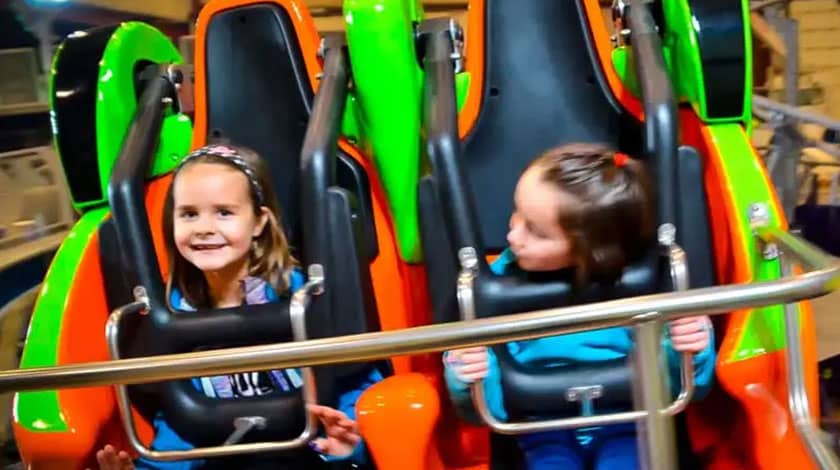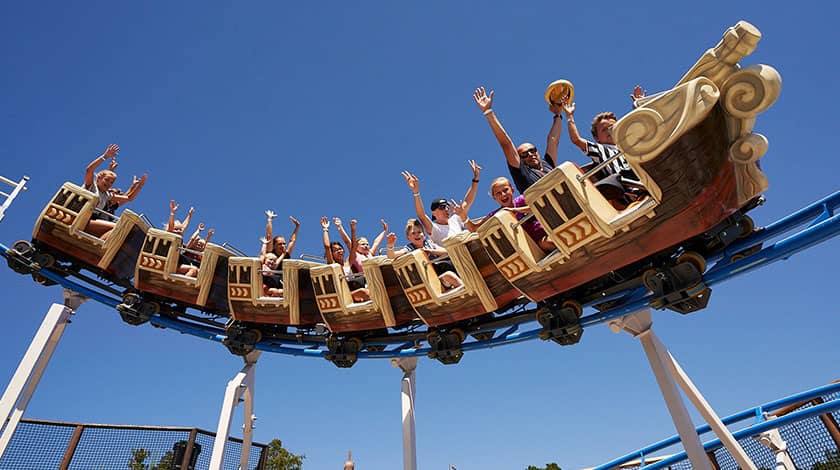Spinning Coaster Roller Coaster


The Spinning Coaster is a gravity-driven roller coaster featuring a robust track supported by vertical columns and a solid base structure. It operates with a single train composed of four passenger units, accommodating up to 16 riders. A lift system with squeeze wheels elevates the train to the main hill, after which gravity propels it along the track back to the station.
Uniquely, each passenger unit rotates on a vertical axis — triggered at the track’s apex by load imbalances — adding an unpredictable twist to the ride. Over-the-shoulder safety restraints ensure maximum security, and the train is capable of running up to three laps with four pre-programmed operational modes. Every element, from the train design to the track layout, is fully customizable.
Technical Data
Number of seats
4 vehicles 4 people each
Height
3.5
Footprint
26x12m
Length route
0.95 if accomp. 120 not accomp.
Hourly Capacity
400kW on request
Power consumption
50kW on request
Speed
6 m/s on request
Product Key Features
Multi-Lap.
16-Passenger Train Capacity.
Rotating Passenger Units.
Gravity-Driven Coaster.
Over-The-Shoulder Restraints.
The history of roller coasters traces back to 17th-century Russia, where tall wooden ramps covered with ice allowed nobles to speed downhill in sleds at nearly 70 km/h. By 1817, Paris introduced the first rail-based ride called Les Montagnes Russes de Belleville, featuring parallel tracks where wheeled carriages raced side by side. The concept quickly spread: in the late 1800s, U.S. mining railways were repurposed into fun attractions, notably the 1884 Gravity Switchback Railway in Coney Island. Early loop experiments were rudimentary and even dangerous, prompting engineers in the early 1900s—like John Miller—to pioneer under-track and side- mounted safety wheels, plus onboard brakes. These improvements made steeper slopes possible without risking derailments. In 1959, the introduction of tubular steel rails revolutionized coaster design: trains could “grip” tracks on all sides, enabling smoother loops and more stable inversions. Over time, advanced restraints and stronger materials emerged, while magnetic and hydraulic launches replaced chain lifts for breathtaking accelerations from 0 to 100 km/h in seconds. Today, the fastest coasters approach 240km/h and exceed 100 meters in height, yet stringent safety protocols and electronic control systems make them impressively secure as well as thrilling. We at Preston & Barbieri are proud to be part of this evolution, committed to combining creativity and high-level engineering for adrenaline-filled but safe rides. One of our most recognizable is the classic “Bruco Mela,” a gentle ride shaped like a friendly caterpillar traversing a giant apple, found in numerous parks worldwide. Despite its simplicity, we prioritize safety with moderate speeds, smooth curves, and dependable restraints, ensuring even the youngest can enjoy a coaster experience. On the other end of the spectrum, our intertwined Double Coaster layout—exemplified by Master Thai, unveiled in 2011—places two trains on a Möbius-style track, letting riders feel the exhilaration of racing in parallel. We have also introduced Splash Coasters, which blend a traditional coaster drop with a refreshing water finale, and Spinning Coasters, where each car rotates freely for unpredictable thrills. In every project, we rely on robust steel structures, advanced braking systems, and ergonomic seating to guarantee passenger well-being. Our daily mission is to push the boundaries of amusement engineering without compromising safety, delivering attractions that honor the legendary heritage of roller coasters.


